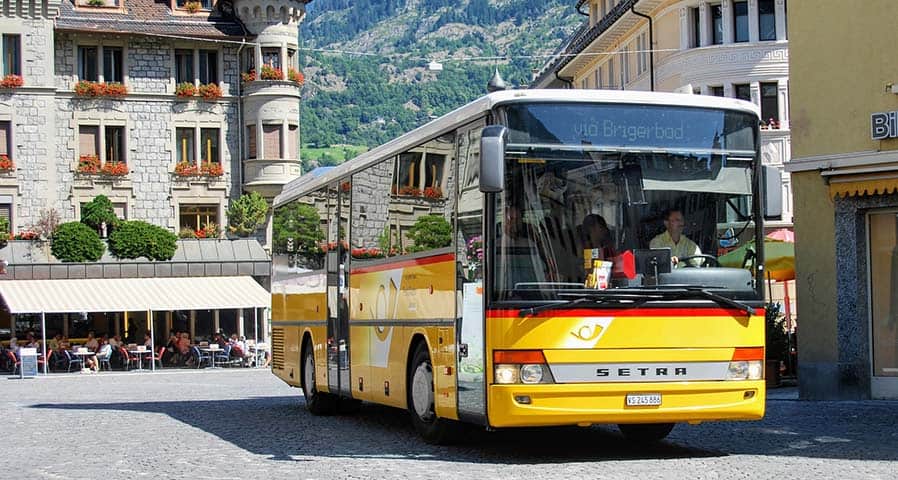Cities, municipalities, and counties can become leaders in their states by committing to electric fleets in the public and private sectors. The increasing number of EV models for work trucks and buses is making it even easier to make the switch to electric vehicles.
Electric fleets also come with significant financial benefits that include lower maintenance and fuel (electricity) costs. Here’s a look at four policies that apply to electric vehicles. These include electric bus zero-emission requirements, fleet funding, light-duty electric truck requirements, and the procurement of EVs.
Electric Bus Requirements by 2030
One of the best ways municipalities can influence other cities in the state is to start rolling out electric buses. Along with reducing fleet operating costs, EV buses are tailpipe emissions-free resulting in improved public health and equity.
Public officials can set timelines requiring the electrification of public transportation by a specific year. The lessons learned from procuring and installing the charging infrastructure necessary to power electric buses can serve as guidance for other fleet vehicles.
Some examples of cities and counties working towards electric fleets include,
- Cities can join the C40 Green and Healthy Streets pledge. It is a commitment to transitioning to a fully electric fleet by 2025.
- Miami-Dade County (Florida) is partnering with Proterra to install 75 chargers to support the area’s 42 new electric buses, making it one of the largest fleets in America.
- Beverly (Massachusetts) is transitioning to a fully electric school bus fleet.
- Charlotte (North Carolina) is working towards the city’s goal of 100% electric buses. Their pilot program is starting with the introduction of 18 EV buses.
- California established a 100% zero emissions goal by 2040 with all new vehicle purchases being fully electric by 2029. The state is working towards reducing carbon emissions by 19 million metric tons by 2050.
- New Jersey’s governor signed legislation to increase the use of zero-emission vehicles in the state to 100% by 2030.
For those considering electrifying their school buses, you are in luck. We have an entire series dedicated to school bus electrification. We suggest starting with; An Introduction to EV School Buses!
Making Electric Fleets Affordable
Transitioning to electric fleets can be cost-prohibitive, especially for smaller municipalities. However, there are funding programs available at the state and federal levels. Furthermore, partnering with electric providers and EV manufacturers can also result in additional grants, rebates, and other financial incentives.
Leasing electric buses is an option worth exploring. To help offset EV battery costs, these components are also available for lease.
Some leasing partners allow you to pay for the EVs as you save money on fuel and maintenance. The money you save monthly running electric buses goes towards paying the vehicles and batteries off. Once your leasing partner has recouped their funds, the EVs belong to the municipality.
Partnering with a private entity is another cost-saving option. You are leasing the vehicles, but the partner is responsible for maintenance and the other aspects associated with electric fleet management.
No matter if you lease, partner, or outright purchase your electric buses, finding an EV charging company that can offer you a turn-key charging experience should be a top priority. Don’t forget to take a deep dive into any EV charging operating System.
Additional Funding Examples
- The Federal Transit Administration (FTA) is allocating $180 million to support the electrification of the nation’s fleets.
- Highland Electric Transportation is a start-up company working to provide businesses with budget-neutral options to electrify their fleets.
- Dominion Energy is present in 18 eastern states and is investing in electric school buses, along with boosting grid reliability.
- The Orlando Utilities Commission (OUC) Charge It program is selling and leasing Level 2 and Level 3 chargers. At the end of the five-year lease, customers have the option of purchasing the charging units.
Here’s a look at how much funding is available for the electrification of public and private fleets.
- Surface Transportation Block Grants: $12 billion
- Congestion Mitigation and Air Quality Improvement (CMAQ) program: $2.5 billion
- Low or No Emission Vehicle Grants: $55 million
- Diesel Emission Reduction Act School Bus Rebate Program: $10 million
- Pennsylvania’s Alternative Fuels Infrastructure Grant Program: $5 million
- Utilities: $1.2 billion approved
- Volkswagen settlement: $3 billion for the mitigation trust fund, $2 billion in ZEV infrastructure (total)
- Regional Greenhouse Gas Initiative (RGGI): $248 million
Making the Transition to Electric Public Transportation
Municipalities can adopt policies encouraging the electrification of public transportation and private fleets. As the number of EV models continues to increase, with more than 100 planned by 2025, companies can find electric vehicles that meet their transportation needs.
When counties and cities set benchmarks for the electrification of light, medium, and heavy-duty trucks, they find it easier to meet their zero-emissions goals.
A few examples of policies being enacted by cities are,
- Ann Arbor (Michigan) set a 2017 policy calling for the electrification of 90% of the city’s light-duty fleets by 2025. The policy will also extend to medium and heavy-duty vehicles.
- Charlotte (North Carolina) is working towards 100% zero carbon emissions by 2030. The policy also requires the electricity produced also be carbon-free.
- Pittsburg (Pennsylvania) is working towards a 100% electric fleet by 2030 with the electricity either renewable or generated at the local level.
- Tallahassee (Florida) is following a policy (Clean Energy Resolution) that calls for the electrification of all light-duty trucks by 2035.
Procuring Electric Vehicles and the Necessary Technology
Guidelines for procuring electric fleet vehicles and the necessary technology are serving as markers as communities make the transition away from fossil fuels. These guidelines can help streamline the process while also ensuring the community’s transportation needs are being met.
Here are a few examples of guidelines being used by cities across the United States.
- Albuquerque (New Mexico) is following guidelines passed in 2020 prioritizing fuel-efficient and carbon-neutral vehicles to reduce tailpipe emissions while saving taxpayers money on fuel costs.
- Seattle (Washington) is using guidelines established in the 2017 Drive Clean Seattle policy that is working to reduce fleet emissions. Currently, the city is working towards a 100% electric fleet by 2023.
- Charlotte (North Carolina) uses its Zero Carbon Fleet program as a way to optimize EV use and charging by identifying which vehicles work best with electrification.
Over 30 cities, including Los Angeles, are part of the 2017 Climate Mayors EV Purchasing Collaborative. They are working to bundle fleet and charging infrastructure needs with members committing to the purchase of more than 4,000 electric vehicles. The collaborative is also providing training that details best practices to help cities easily transition to electric fleets.
Municipality Fleet Electrification with Apogee Charging Solutions
Municipality Fleet Electrification is an exciting time but can also bring major stress when trying to navigate the electrification process alone. Apogee Charging Solution has dedicated municipality and fleet electrification specialists that can help walk you through your EV charging options. We offer a national turn-key EV charging experience that covers product, infrastructure, installation, rebates and grants, as well as operating system management.
The experts with Apogee Charging Solutions are standing by to answer any questions you may have. You can call 484-816-2076, email [email protected], or schedule a call that fits your need by clicking the button below!








0 Comments